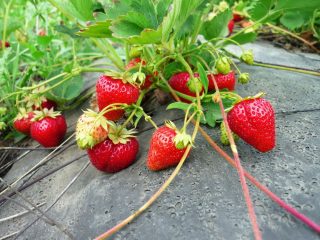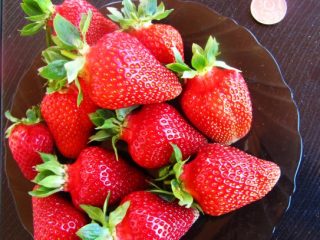Content
Homeland remontant strawberries Diamond is considered California. It was there that the variety was bred by university specialists. In Russia, strawberries have spread among many gardeners in different regions. Diamant strawberries are famous for their taste, high yield, and quick adaptation to climatic conditions.
Main characteristics of the variety
Review of the Diamant strawberry, description of the variety, photos, reviews from gardeners, let's start with the characteristics of the crop. Remontant strawberry belongs to the group of large-fruited crops. The berries grow in an elongated cone shape. The skin is shiny, bright red. At technical maturity it has an orange tint. The weight of the berry is about 32 g, but it all depends on the growing conditions. The ripe Diamond fruit is dense. The light red pulp accumulates a large amount of sugar, but is not rich in juice. Thanks to such indicators, crops can be transported over long distances.
The Diamant strawberry variety has three main advantages:
- high productivity;
- presentation of berries;
- good taste.
Continuing to consider Diamant garden strawberries, description of the variety, photos, reviews, it is worth paying attention to the plant itself. Strawberry bushes grow spreading, tall with large leaves. The inflorescences are firmly held on the peduncle and protrude above the level of the foliage. With the onset of active fruit set, the formation of whiskers occurs. Diamond strawberries are grown in open and closed ground. Strawberries can bear fruit well in flower pots suspended using flowerpots.
Features of care
To grow the Diamant variety of remontant strawberries, you need to know the peculiarities of caring for the crop. Strawberries are resistant to diseases and pests, but not as much as regular garden strawberries. Additionally, the crop is very sensitive to soil composition and regularity of watering. Because of these features, gardeners have to follow the following care rules:
- Regular watering of Diamant strawberries is carried out only with warm water. To do this, a large storage tank is placed on the site. It is better to water early in the morning or late in the evening.
- Loosening the soil is necessary after rain or every watering. When the roots are visible, hill up the strawberries.
- Weeds should not grow between the bushes and between the rows. Regular weeding will help get rid of diseases and get a good harvest.
- Strawberry Diamant responds well to soil mulching. A layer of sawdust, peat, pine needles or straw will prevent moisture evaporation during drought, and will also free the gardener from unnecessary weeding.
- Strawberries of the Diamant variety love root feeding and leaf feeding. Strawberries react well to manure and bird droppings solution.For spraying on the leaves, infusions of herbs, such as nettle, are prepared.
- Diamant strawberry plantings must be subjected to preventive spraying. Typically, gardeners use copper oxychloride or fungicides.
- In the fall, after harvesting, the foliage of strawberries is cut off. Sick and weak bushes should be dug up and thrown away. Spud up the exposed roots and spread a thick layer of mulch. For the winter, cover with spruce branches or non-woven fabric.
If you look closely, there is nothing complicated or new in caring for Diamant strawberries. It is necessary to fulfill the standard requirements, as for most other varieties of strawberries.
Planting and reproduction features
Continuing the review of Diamant strawberries, descriptions of the variety, photos, reviews, we will consider methods of propagating the crop. Gardeners are accustomed to growing strawberries from whiskers. If the Diamant variety does not grow at home and there is nowhere to buy seedlings, the only option to start a crop in your garden is to purchase seeds.
Diamond strawberries will grow on any soil, but the amount of harvest, size and taste of the berries depend on its composition. The variety loves light soil. The optimal acidity level is from 5.0 to 6.5.
Growing strawberries from seeds occurs in the following order:
- To sow strawberry seeds, prepare containers about 8 cm high. Any boxes, glasses, or flower pots will do. When grown in a common container, seedlings will have to be pricked before planting.
- It is better to buy a substrate for sowing strawberry seeds in a store. The soil mixture is disinfected from harmful microorganisms and has all nutritional additives. When preparing the substrate yourself, take 3 parts sand and 5 parts humus.You can use compost, peat, or in the worst case, ordinary soil from the garden.
- Containers prepared for sowing are disinfected with a strong solution of manganese. A drainage layer is laid on the bottom. Any small stones will do. Pour strawberry soil mixture onto the drainage and lightly moisten it with a spray bottle.
- In each cup, place 1-2 pieces of Diamant strawberry seeds on the surface of the soil. There are no grooves for grains. The seeds are simply pressed into the ground with your finger. There is no need to crush the top with earth either. If the sowing of Diamant strawberries is carried out in a common container, then the seeds are thrown in bulk.
- After sowing is completed, the soil on top is moistened again using a sprayer. The crops are covered with film or transparent glass. Ventilation is done daily, raising the shelter for a short time. When the soil dries out, use a sprayer to moisten it.
If you come across high-quality strawberry seeds of the Diamant variety, then at an ambient temperature of +20OThe shoots will appear in 1–2 weeks. After pipping the sprouts, the film is removed from the crops. If picking is necessary, the procedure begins after the appearance of two full-fledged leaves.
Gardeners determine the time for sowing strawberry seeds individually based on the weather conditions of the region. However, strawberry seedlings do not outgrow as much as some garden crops, so you can sow from January to March.
At the time of planting the seedlings, the strawberries must form at least two strong leaves.With the onset of warm weather, Diamond seedlings are planted in the garden. A distance of approximately 30–50 cm is maintained between seedlings. After planting and watering all the strawberries, the surface of the soil in the garden bed is covered with mulch.
Top dressing
Any strawberry, especially large-fruited varieties, needs feeding. The procedure must be regular and dosed. The best fertilizer is a solution of bird droppings or manure. The most useful is considered to be chicken droppings, and cow manure.
A good fertilizer for strawberries is watering them with an infusion of freshly cut grass. Organic fertilizing must be alternated with the addition of minerals. Typically, saltpeter or special complexes for berry crops are used. Ash is poured in small quantities under the bushes. In addition to feeding, organic matter prevents the proliferation of pests.
Disease and pest control
Concluding the review of the description of the Diamant strawberry variety, we must dwell on the problem of diseases and pests. More often, strawberries are destroyed by leaf beetle, strawberry mite or nematode. Pests and pathogens can spread with purchased seedlings. Before planting, seedlings are doused with hot water. Onions or garlic are good for repelling pests from strawberries. Marigolds can be planted next to the garden bed.
Gray rot is very dangerous for remontant strawberries. The disease is more often observed in beds with dense planting of bushes. Weeds are also a spreader of rot. The strawberry bed should be clean and well ventilated. A free passage is created between the bushes. In spring, darkened and frozen leaves are removed.Preventive treatment with fungicides helps well against gray rot.
The video talks about garden strawberries:
Reviews
Despite the slight difficulties in growing and caring for the Diamant strawberry, reviews from gardeners are more inclined in a positive direction.













